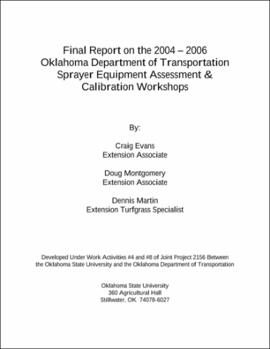| dc.description.abstract | This report documents the findings of herbicide sprayer calibration workshops conducted as a part of the 2004-2006 Joint Project 2156: ROADSIDE VEGETATION MANAGEMENT TRAINING, CONSULTATION & DEVELOPMENT OF LEARNING RESOURCES. This Joint Project was between the Oklahoma State University (OSU) and the Oklahoma Department of Transportation (ODOT). Early on in this Joint Project, two project initiatives were identified as very closely related training and assessment issues. These were Work Activity #4: Conduct Workshops on Equipment Trouble Shooting and Calibration of Spray Equipment and Work Activity #8: the Assessment of the Status of Each ODOT Field Division抯 Herbicide Application Equipment/Preparation of an ODOT Herbicide Equipment Inventory Report. Seeing an opportunity to improve productivity and efficiency, in January of 2005 OSU RVM personnel requested and were granted permission to combine these two activities into one assessment & training effort. The objectives of the combined Initiatives #4 and #8 on Joint Project 2156 became: 1.) review each ODOT Herbicide spray crew抯 application equipment, 2.) report on the condition of that equipment, 3.) make recommendations concerning improving the performance of the equipment and 4.) train each crew on the proper sprayer calibration procedures and use of speed adjustment charts. In 2004 � 2006, OSU RVM personnel visited each ODOT division. This Final Report was generated to document the individual and overall findings on the status and condition of equipment. We assessed, inventoried and calibrated a total of 82 ODOT roadside spray rigs. We discussed and reported on the design and function of each spray rig component to the respective spray crew to which the unit was assigned. A detailed discussion of the individual findings is covered in Sections 2.0 � 9.0 of this report. A state-wide summary of the findings is covered in Section 10. A 搑eport card� (Appendix A.) was generated and sent back to the field unit within 2 weeks of the calibration workshop. A total of 269 ODOT herbicide applicators received 揾ands on� calibration training on their respective spray rigs. This included training on proper sprayer calibration procedures and use of speed adjustment charts (Appendices B. and C.). In previous Joint Project spray-equipment-inventories the respondents (ODOT herbicide applicators) merely filled out survey sheets to describe the number but most importantly the condition of pieces of equipment. In this Joint Project, OSU RVM personnel were able to physically access all available ODOT spray rigs. This had not occurred during previous equipment inventories. Over the years the most important outcome of the original herbicide equipment inventory surveys was to allow ODOT insight into what equipment needed to be replaced or brought back to operational status. With this in mind, we feel that the most important outcome of our physical access to the equipment on this Joint Project has been the ability to facilitate an immediate assessment of the condition of herbicide application equipment such that ODOT maintenance divisions were able to respond to suggestions on a timely basis. In 2005, ODOT herbicide applicators treated 98,556 acres (2005 Annual Oklahoma Department of Transportation Herbicide Program Report) of highway easement. Most of those acres were treated utilizing large capacity, truck mounted roadside sprayers. These sprayers consist of large spray tanks and necessary components that are 搒kid� mounted in the back of ODOT trucks. Due to the physics involved in proper sprayer operation, several basic components are required on properly functioning spray rigs. These being: 1) a tank to hold the herbicide solution (herbicide and carrier). 2) a pump generating pressure to move the herbicide and carrier through a piping system. 3) a delivery system consisting of those parts installed past the pumping system to include pressure regulators and spray nozzles that deposit the herbicide/carrier on targeted weeds. 4) a digital speedometer capable of readouts in tenths of a mile. Currently, ODOT spray trucks are using either Boombuster nozzles or solid stream tip systems and most spray rigs use centrifugal pumps for pressure generation. Motors powering the pumps are either hydraulic or auxiliary gasoline (gas) engines. At this point it is important to note that OSU Roadside Vegetation Management (RVM) personnel are professionals and proficient in assessing the status of the sprayer components. However, our expertise is limited in the area of truck hydraulic system mechanics or gasoline engine mechanics. If all of the required sprayer components are in place and functioning properly, these sprayers can be calibrated to deliver accurate rates of herbicides. Deliver of accurate herbicide rates is critical to achieving effective weed control. To make an accurate roadside herbicide application, applicators must know how many gallons per acre (GPA) they need to deliver from the sprayer (indicated on the herbicide label), what the effective spray pattern width (SW) is and how many gallons per minute (GPM) the sprayer delivery system is putting out. Knowing these parameters allow applicators to determine what speed the truck operator must maintain to deliver an accurate and desired rate (Appendix C.). Comments from ODOT applicators attending this training were very positive and OSU RVM recommendations were made in a sincere effort to allow applicators to operate their spray rigs in a confident, knowledgeable and accurate fashion. Most spray rigs had small individual problems that could be fixed by the field crews. Major issues were addressed in reports to respective division maintenance engineers. We would like to thank the divisions for their participation in this training and assessment endeavor. Without their cooperation, the scope of this report would have been dramatically limited. We encourage suggestions as to how this report can be made more informative and useful. As always we welcome and encourage input from all levels & branches within ODOT. | |
